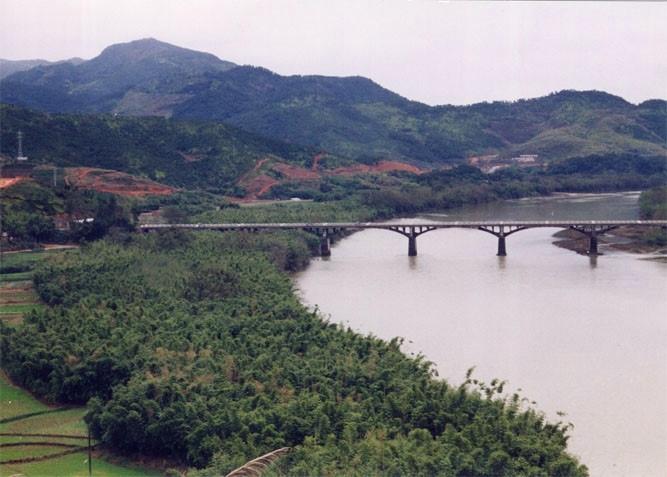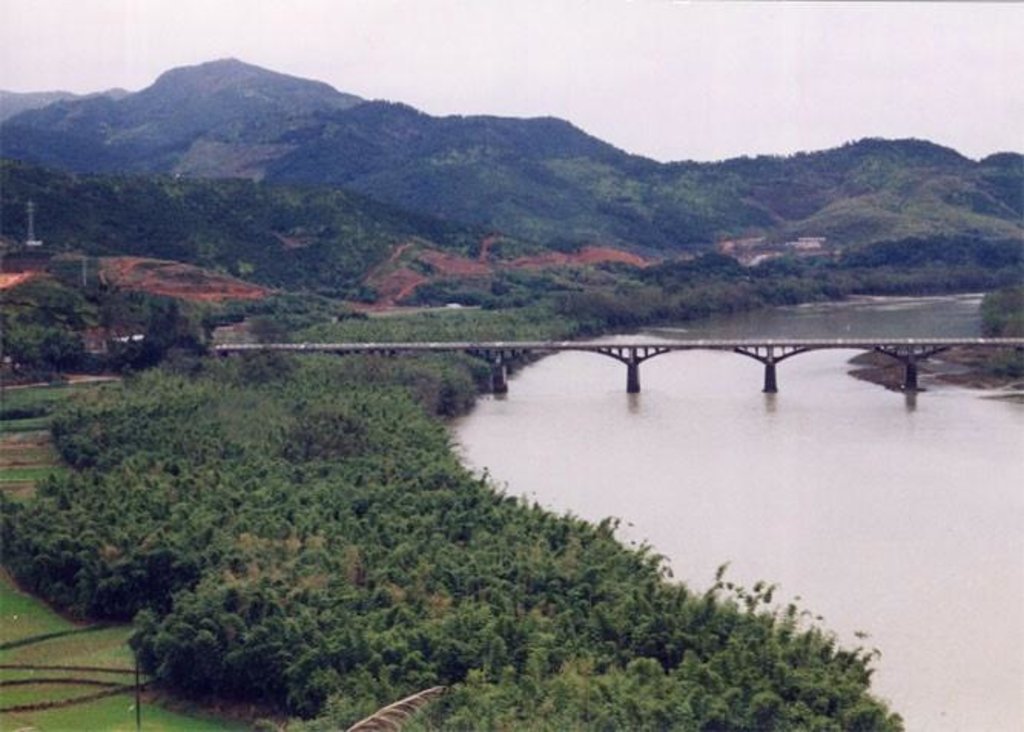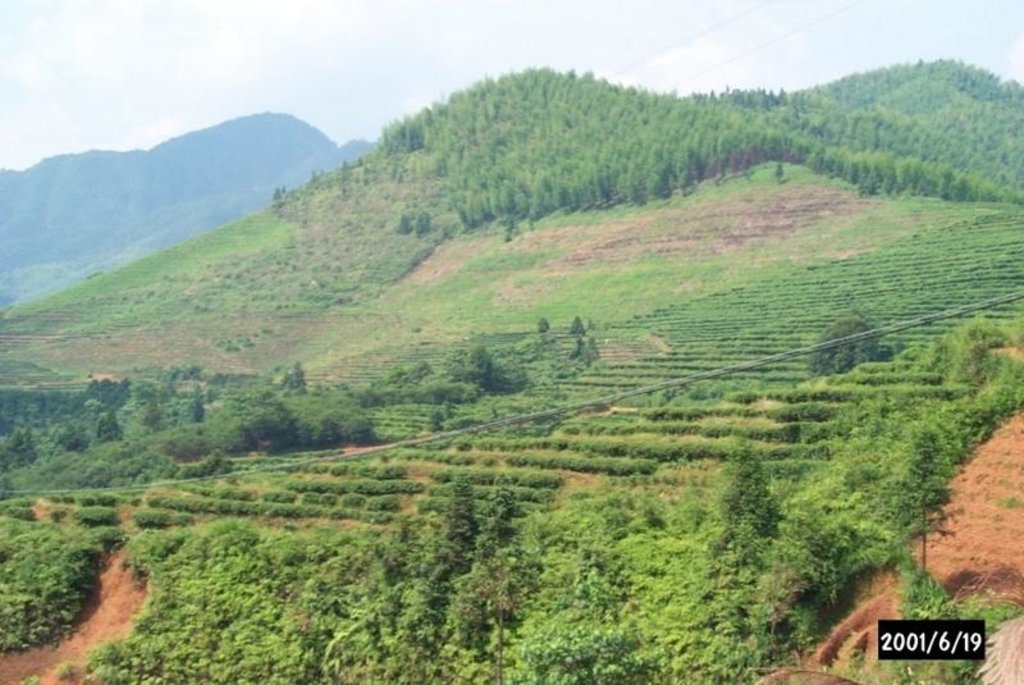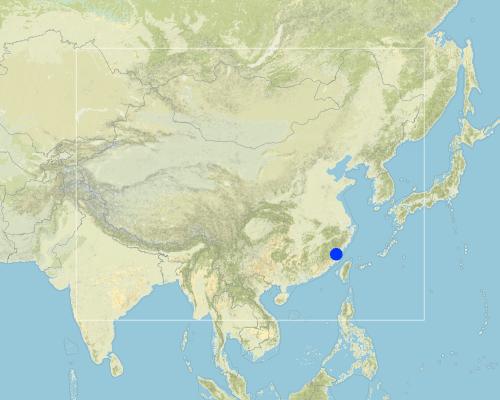Comprehensive Development & Management of a Small Watershed [ប្រទេសចិន]
- ការបង្កើត៖
- បច្ចុប្បន្នភាព
- អ្នកចងក្រង៖ Unknown User
- អ្នកកែសម្រួល៖ –
- អ្នកត្រួតពិនិត្យ David Streiff
Intergraded development of a small watershed
technologies_971 - ប្រទេសចិន
ពិនិត្យមើលគ្រប់ផ្នែក
ពង្រីកមើលទាំងអស់ បង្រួមទាំងអស់1. ព័ត៌មានទូទៅ
1.3 លក្ខខណ្ឌទាក់ទងទៅនឹងការប្រើប្រាស់ទិន្នន័យដែលបានចងក្រងតាមរយៈ វ៉ូខេត
តើពេលណាដែលទិន្នន័យបានចងក្រង (នៅទីវាល)?
19/06/2001
អ្នកចងក្រង និង(បុគ្គលសំខាន់ៗ)យល់ព្រមទទួលយកនូវលក្ខខណ្ឌនានាទាក់ទងទៅនឹងការប្រើប្រាស់ទិន្នន័យដែលបានចងក្រងតាមរយៈវ៉ូខេត:
បាទ/ចា៎
1.5 ការយោងទៅលើកម្រងបញ្ជីសំណួរនៃវិធីសាស្ត្រផ្សព្វផ្សាយ SLM
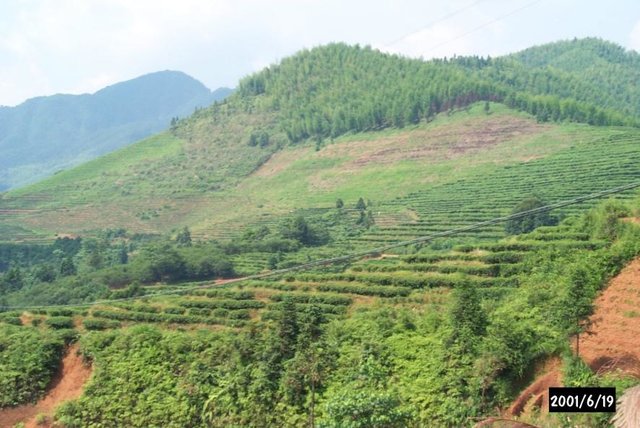
Comprehensive Development & Management of a Small Watershed [ប្រទេសចិន]
The comprehensive measures including interplanting & intercropping are applied in the small watershed to control soil and water loss and improve land production and farmers' income.
- អ្នកចងក្រង៖ Unknown User
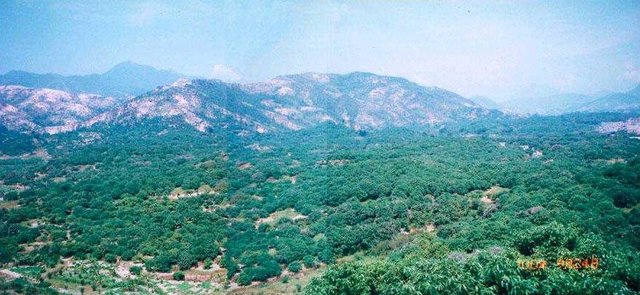
Interplanting fruit trees of Longan, Peach, Plum etc. [ប្រទេសចិន]
Interplanting plum, peach and other fruit trees in longan orchard on level terraces in order to prevent soil and water loss and improve production of the fruit trees.
- អ្នកចងក្រង៖ zhangsheng LIU
2. ការពណ៌នាពីបច្ចេកទេស SLM
2.1 ការពណ៌នាដោយសង្ខេបពីបច្ចេកទេស
និយមន័យបច្ចេកទេស:
The comprehensive measures including interplanting & intercropping are applied in the small watershed to control soil and water loss and improve integrated production.
2.2 ការពណ៌នាលម្អិតពីបច្ចេកទេស
ការពណ៌នា:
Based on the national conditions and soil and water loss in the area, the corresponding SWC measures were adopted to pursue the targets including: 1. Closing the hilly and mountain area of 224ha for the timber forest and grass growing as well as preventing soil and water loss; 2. Adjusting the land use structure so as to strengthen the comprehensive development of the hilly land as well as crop land irrigation; 3. Changing the area of W & S loss to economic vegetation land; 4. Constructing reservoirs and roads.
2.3 រូបភាពនៃបច្ចេកទេស
2.5 ប្រទេស/តំបន់/ទីតាំងកន្លែង ដែលបច្ចេកទេសត្រូវបានអនុវត្ត និងបានគ្រប់ដណ្តប់ដោយការវាយតម្លៃនេះ
ប្រទេស:
ប្រទេសចិន
តំបន់/រដ្ឋ/ខេត្ត:
Fujian Province
Map
×2.6 កាលបរិច្ឆេទនៃការអនុវត្ត
ប្រសិនបើមិនច្បាស់ឆ្នាំ សូមបញ្ជាក់កាលបរិច្ឆេទដែលប្រហាក់ប្រហែល:
- តិចជាង 10ឆ្នាំមុន (ថ្មី)
2.7 ការណែនាំពីបច្ចេកទេស
សូមបញ្ជាក់តើបច្ចេកទេសត្រូវបានណែនាំឱ្យអនុវត្តដោយរបៀបណា:
- តាមរយៈគម្រោង / អន្តរាគមន៍ពីខាងក្រៅ
មតិយោបល់ (ប្រភេទនៃគម្រោង ។ល។):
Based on the long term experiences of the mass's practice in SWC, the SWC specialists innovated through guidance, design and implementation of local water & soil conservation.
3. ចំណាត់ថ្នាក់នៃបច្ចេកទេស SLM
3.1 គោលបំណងចម្បង (១ ឬច្រើន) នៃបច្ចេកទេសនេះ
- ការពារតំបន់ទីជម្រាល/តំបន់ខ្សែទឹកខាងក្រោមបញ្ចូលជាមួយបច្ចេកទេសផ្សេងទៀត
3.2 ប្រភេទដីប្រើប្រាស់មួយប្រភេទ (ច្រើនប្រភេទ) ដែលបានអនុវត្តបច្ចេកទេស

ដីដាំដំណាំ
- ដំណាំប្រចាំឆ្នាំ
ដំណាំចម្បង (ដំណាំកសិ-ឧស្សាហកម្ម និងដំណាំស្បៀង) :
Rice-rice; Tea, grape etc.

ដីព្រៃ/ដីដាំដើមឈើ
ផលិតផល និងសេវាកម្ម:
- ឈើហ៊ុប
- វាលស្មៅ
- ការអភិរក្ស/ការការពារធម្មជាតិ
មតិយោបល់:
Major land use problems (compiler’s opinion): The layout of vegetation is not rational. The traffic is not convenient.
Major land use problems (land users’ perception): Lack of new species and SWC technique. Hopefully more funds could be supported from government.
Grazingland comments: Reclaiming fish pools area of 5.6 ha, stall breeding chicken, duck etc.
Problems / comments regarding forest use: Planting young bamboo in the sparse woodland (about 135 ha) in the western watershed and planting lotus after deforesting the woodland (36.7 ha) in the southwestern watershed as well as changing the adult tea gardens to afforest in the northeast watershed.
Forest products and services: timber, grazing / browsing, nature conservation / protection
Type of grazing system comments: Reclaiming fish pools area of 5.6 ha, stall breeding chicken, duck etc.
3.3 ព័ត៌មានបន្ថែមអំពីអ្នកប្រើប្រាស់ដី
ការផ្គត់ផ្គង់ទឹកនៅកន្លែងអនុវត្តបច្ចេកទេស:
- ទឹកភ្លៀង
មតិយោបល់:
Water supply also mixed rainfed-irrigated
ចំនួនសារដែលដាំដំណាំក្នុងមួយឆ្នាំ:
- 1
សូមបញ្ជាក់:
Longest growing period in days: 365Longest growing period from month to month: Jan - Dec
3.4 ក្រុម SLM ដែលបច្ចេកទេសស្ថិតនៅក្នុង
- ការគ្រប់គ្រងទឹកលើដី (ទឹកធ្លាក់ ទន្លេ បឹង សមុទ្រ)
3.5 ការសាយភាយនៃបច្ចេកទេស
បញ្ជាក់ពីការសាយភាយនៃបច្ចេកទេស:
- ត្រូវបានផ្សព្វផ្សាយត្រឹមតំបន់មួយ
ប្រសិនបើបច្ចេកទេសត្រូវបានសាយភាយពាសពេញតំបន់ណាមួយ សូមកំណត់ទំហំផ្ទៃដីអនុវត្តន៍:
- 1-10 គម2
មតិយោបល់:
Total area covered by the SLM Technology is 5.93 m2.
Xinxili small watershed is located in southern Zhenghe county. It belongs to administration of Jiefang village of Xiongshan town including three villages. The area of the watershed is about 606 ha. The weather in the region is sub-tropical monsoon climate with artificial vegetation. The soil type is red soil.
3.6 វិធានការ SLM ដែលបញ្ចូលនូវបច្ចេកទេស

វិធានការក្សេត្រសាស្ត្រ
- A1: ដំណាំ/គម្របដី

វិធានការរចនាស័ម្ពន្ធ
- S7: ការប្រមូលទឹកស្តុកទុក/ផ្គត់ផ្គង់ទឹក/ សម្ភារៈស្រោចស្រព

វិធានការគ្រប់គ្រង
- M1: ការផ្លាស់ប្តូរប្រភេទដីប្រើប្រាស់
មតិយោបល់:
Type of agronomic measures: mixed cropping / intercropping, mulching, minimum tillage, contour tillage
3.7 កំណត់ប្រភេទនៃការធ្លាក់ចុះគុណភាពដីសំខាន់ៗដែលបច្ចេកទេសនេះបានដោះស្រាយ

ការហូរច្រោះដីដោយសារទឹក
- Wt: ការបាត់ដីស្រទាប់លើដោយការហូរច្រោះ
- Wg: ការកកើតឡើងនូវកំទេចកំទីដីស្រទាប់ក្រោម

ការបាត់ដីដោយសារខ្យល់
- Et: ការបាត់បង់ដីស្រទាប់លើ

ការធ្លាក់ចុះសារធាតុគីមីក្នុងដី
- Cn: ការថយចុះជីជាតិ និងកាត់បន្ថយបរិមាណសារធាតុសរីរាង្គ (មិនកើតឡើងដោយការហូរច្រោះទេ)

ការបាត់បង់ទឹក
- Ha: ការថយចុះសំណើមដី
មតិយោបល់:
Main type of degradation addressed: Wt: loss of topsoil / surface erosion
Secondary types of degradation addressed: Wg: gully erosion / gullying, Et: loss of topsoil, Cn: fertility decline and reduced organic matter content, Ha: aridification
Main causes of degradation: deforestation / removal of natural vegetation (incl. forest fires) (population increasing and lack of fuel), poverty / wealth (Lack of captial: Low living standard of the local people and lack of funds.)
Secondary causes of degradation: over-exploitation of vegetation for domestic use (neglecting ecological benefit, overfelling forest), other natural causes (avalanches, volcanic eruptions, mud flows, highly susceptible natural resources, extreme topography, etc.) specify (Sandy and loose red soil.)
3.8 ការពារ កាត់បន្ថយ ឬស្តារឡើងវិញនៃការធ្លាក់ចុះគុណភាពដី
បញ្ជាក់ពីគោលដៅរបស់បច្ចេកទេស ដែលផ្តោតទៅការធ្លាក់ចុះគុណភាពដី:
- ការកាត់បន្ថយការធ្លាក់ចុះគុណភាពដី
4. បច្ចេកទេសជាក់លាក់ សកម្មភាពអនុវត្ត ធាតុចូល និងថ្លៃដើម
4.2 លក្ខណៈពិសេសនៃបច្ចេកទេស/ ពណ៌នាពីគំនូរបច្ចេកទេស
Technical knowledge required for field staff / advisors: moderate
Technical knowledge required for land users: moderate
Main technical functions: improvement of ground cover, Improvement of soil structure
Secondary technical functions: control of dispersed runoff: impede / retard, control of concentrated runoff: retain / trap
Mixed cropping / intercropping
Remarks: Intercropping/mixed cropping
Mulching
Material/ species: Straw
Quantity/ density: all crop a
Remarks: strips
Trees/ shrubs species: fir, bamboo, horsetail pine,
Fruit trees / shrubs species: pear, loquat, peach, greengage
Slope (which determines the spacing indicated above): 25.00%
If the original slope has changed as a result of the Technology, the slope today is (see figure below): 20.00%
Gradient along the rows / strips: 20.00%
Construction material (earth): With some stone
Slope (which determines the spacing indicated above): 35.00%
If the original slope has changed as a result of the Technology, the slope today is: 25.00%
Lateral gradient along the structure: 60.00%
For water harvesting: the ratio between the area where the harvested water is applied and the total area from which water is collected is: 1:10.00
4.3 ព័ត៌មានទូទៅដែលពាក់ព័ន្ធនឹងការគណនាធាតុចូល និងថ្លៃដើម
កំណត់រូបិយប័ណ្ណសម្រាប់ថ្លៃដើម:
- ដុល្លារអាមេរិក
កំណត់ថ្លៃឈ្នួលជាមធ្យមនៃការជួលកម្លាំងពលកម្មក្នុងមួយថ្ងៃ:
1.44
4.4 សកម្មភាពបង្កើត
| សកម្មភាព | ប្រភេទវិធានការ | ពេលវេលា | |
|---|---|---|---|
| 1. | closing mountain to afforest | សារពើរុក្ខជាតិ | 1990 |
| 2. | planting bamboo | សារពើរុក្ខជាតិ | 1990 |
| 3. | bamboo forest cultivated | សារពើរុក្ខជាតិ | 1990 |
| 4. | changing farmland to forest | សារពើរុក្ខជាតិ | 1990 |
| 5. | planting fruit trees | សារពើរុក្ខជាតិ | 1990 |
| 6. | Building sluice dams | រចនាសម្ព័ន្ធ | 1990 |
| 7. | road constructing | រចនាសម្ព័ន្ធ | 1990 |
4.5 ថ្លៃដើម និងធាតុចូលដែលត្រូវការសម្រាប់ការបង្កើតបច្ចេកទេស
មតិយោបល់:
Duration of establishment phase: 72 month(s)
4.6 សកម្មភាពថែទាំ
| សកម្មភាព | ប្រភេទវិធានការ | ពេលវេលា/ ភាពញឹកញាប់ | |
|---|---|---|---|
| 1. | fertilizing | សារពើរុក្ខជាតិ | 1990-1999 /3 |
| 2. | cleaning out ruderal | សារពើរុក្ខជាតិ | 1990-1999 /2 |
| 3. | Preventing and curing illness and insect pests | សារពើរុក្ខជាតិ | 1990-1999 /3 |
| 4. | Broadening road | រចនាសម្ព័ន្ធ | 1995/timely |
| 5. | highway maintenance | រចនាសម្ព័ន្ធ | 1995/timely |
4.7 កំណត់ថ្លៃដើមសម្រាប់ការថែទាំ/ សកម្មភាពរបស់បច្ចេកទេស (ក្នុងរយៈពេលមួយឆ្នាំ)
មតិយោបល់:
Size of the variable structural measures and areas of grass planting.
4.8 កត្តាសំខាន់បំផុតដែលមានឥទ្ធិពលដល់ការចំណាយ
ពណ៌នាពីកត្តាប៉ះពាល់ចម្បងៗទៅលើថ្លៃដើម:
Because mechanic machines are not available, more labor forces are needed costing much. In addition, the expense for seeding, fertilizer, flagstone used in building dams take most of the total fees.
5. លក្ខណៈបរិស្ថានធម្មជាតិ និងមនុស្ស
5.1 អាកាសធាតុ
បរិមាណទឹកភ្លៀងប្រចាំឆ្នាំ
- < 250 មម
- 251-500 មម
- 501-750 មម
- 751-1,000 មម
- 1,001-1,500 មម
- 1,501-2,000 មម
- 2,001-3,000 មម
- 3,001-4,000 មម
- > 4,000 មម
កំណត់បរិមាណទឹកភ្លៀង (បើដឹង) ជា មីលីម៉ែត្រ:
1609,00
តំបន់កសិអាកាសធាតុ
- សើម
5.2 សណ្ឋានដី
ជម្រាលជាមធ្យម:
- រាបស្មើ (0-2%)
- ជម្រាលតិចតួច (3-5%)
- មធ្យម (6-10%)
- ជម្រាលខ្ពស់បន្តិច (11-15%)
- ទីទួល (16-30%)
- ទីទួលចោត (31-60%)
- ទីទួលចោតខ្លាំង (>60%)
ទម្រង់ដី:
- ខ្ពង់រាប
- កំពូលភ្នំ
- ជម្រាលភ្នំ
- ជម្រាលទួល
- ជម្រាលជើងភ្នំ
- បាតជ្រលងភ្នំ
តំបន់តាមរយៈកម្ពស់ :
- 0-100 ម
- 101-500 ម
- 501-1,000 ម
- 1,001-1,500 ម
- 1,501-2,000 ម
- 2,001-2,500 ម
- 2,501-3,000 ម
- 3,001-4,000 ម
- > 4,000 ម
5.3 ដី
ជម្រៅដីជាមធ្យម:
- រាក់ខ្លាំង (0-20 សម)
- រាក់ (21-50 សម)
- មធ្យម (51-80 សម)
- ជ្រៅ (81-120 សម)
- ជ្រៅខ្លាំង (> 120 សម)
សារធាតុសរីរាង្គនៅស្រទាប់ដីខាងលើ:
- ខ្ពស់ (>3%)
បើអាចសូមភ្ជាប់ការពណ៌នាពីដីឱ្យបានច្បាស់ ឬព័ត៌មានដែលអាចទទួលបាន ឧ. ប្រភេទដី, pH ដី/ ជាតិអាស៊ីត, សមត្ថភាពផ្លាស់ប្តូរកាចុង, វត្តមាននីត្រូសែន, ភាពប្រៃ ។ល។:
soil texture: granite and fiber rock
Soil fertility: medium
Soil drainage / infiltration: good
Soil water storage capacity: high
5.6 លក្ខណៈនៃអ្នកប្រើប្រាស់ដីដែលអនុវត្តបច្ចេកទេស
ចំណូលក្រៅកសិកម្ម:
- 10-50% នៃចំណូល
កម្រិតជីវភាព:
- មិនល្អ
- មធ្យម
កម្រិតប្រើប្រាស់គ្រឿងយន្ត:
- ប្រើកម្លាំងពលកម្ម
- ប្រើកម្លាំងសត្វ
សូមបញ្ជាក់ពីលក្ខណៈពាក់ព័ន្ធផ្សេងទៀតអំពីអ្នកប្រើប្រាស់ដី:
Population density: 50-100 persons/km2
Annual population growth: 0.5% - 1%
and own 2% of the land.
and own 2% of the land.
and own 72% of the land.
and own 10% of the land.
and own 8% of the land.
Off-farm income specification: The benefit of SWC implementation is about 1.03 million US dollars. Among them, 257,289 US Dollars from the agricultural production, 145,301 USD from the forest industry and 286,746 USD from others.
5.8 ភាពជាម្ចាស់ដី កម្មសិទ្ធប្រើប្រាស់ដី និងកម្មសិទ្ធប្រើប្រាស់ទឹក
ភាពជាម្ចាស់ដី:
- រដ្ឋ
កម្មសិទ្ធិប្រើប្រាស់ដី:
- ឯកជន
6. ផលប៉ះពាល់ និងការសន្និដ្ឋាន
6.1 ផលប៉ះពាល់ក្នុងបរិវេណអនុវត្តបច្ចេកទេសដែលកើតមាន
ផលប៉ះពាល់ទៅលើអេកូឡូស៊ី
វដ្តទឹក/លំហូរ
លំហូរទឹកលើផ្ទៃដី
គុណភាពមុន SLM:
40
គុណភាពក្រោយ SLM:
30
ដី
ការបាត់បង់ដី
គុណភាពមុន SLM:
25
គុណភាពក្រោយ SLM:
5
6.4 ការវិភាគថ្លៃដើម និងអត្ថប្រយោជន៍
តើផលចំណេញ និងថ្លៃដើមត្រូវបានប្រៀបធៀបគ្នាយ៉ាងដូចម្តេច (ទស្សនៈរបស់អ្នកប្រើប្រាស់ដី)?
រយៈពេលខ្លី:
អវិជ្ជមានតិចតួច
រយៈពេលវែង:
វិជ្ជមានខ្លាំង
តើផលចំណេញ និងការថែទាំ/ ជួសជុលត្រូវបានប្រៀបធៀបគ្នាយ៉ាងដូចម្តេច (ទស្សនៈរបស់អ្នកប្រើប្រាស់ដី)?
រយៈពេលខ្លី:
វិជ្ជមានខ្លាំង
រយៈពេលវែង:
វិជ្ជមានខ្លាំង
6.5 ការទទួលយកបច្ចេកទេស
- ច្រើនជាង 50%
បើអាច សូមបញ្ជាក់ពីបរិមាណ (ចំនួនគ្រួសារ និង/ ឬតំបន់គ្របដណ្តប់):
510 households
ក្នុងចំណោមគ្រួសារទាំងអស់ដែលអនុវត្តបច្ចេកទេស តើមានប៉ុន្មានគ្រួសារដែលចង់ធ្វើដោយខ្លួនឯង ដោយមិនទទួលបានសម្ភារៈលើកទឹកចិត្ត/ប្រាក់ឧបត្ថម្ភ?:
- 10-50%
មតិយោបល់:
80% of land user families have adopted the Technology with external material support
410 land user families have adopted the Technology with external material support
Comments on acceptance with external material support: estimates
20% of land user families have adopted the Technology without any external material support
100 land user families have adopted the Technology without any external material support
Comments on spontaneous adoption: estimates
There is a moderate trend towards spontaneous adoption of the Technology
Comments on adoption trend: Even without fund support, rich land users could gain added income from the implementation of SWC technique.
ការតភ្ជាប់ និងម៉ូឌុល
ពង្រីកមើលទាំងអស់ បង្រួមទាំងអស់ការតភ្ជាប់

Comprehensive Development & Management of a Small Watershed [ប្រទេសចិន]
The comprehensive measures including interplanting & intercropping are applied in the small watershed to control soil and water loss and improve land production and farmers' income.
- អ្នកចងក្រង៖ Unknown User

Interplanting fruit trees of Longan, Peach, Plum etc. [ប្រទេសចិន]
Interplanting plum, peach and other fruit trees in longan orchard on level terraces in order to prevent soil and water loss and improve production of the fruit trees.
- អ្នកចងក្រង៖ zhangsheng LIU
ម៉ូឌុល
គ្មានម៉ូឌុល


